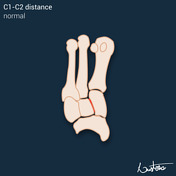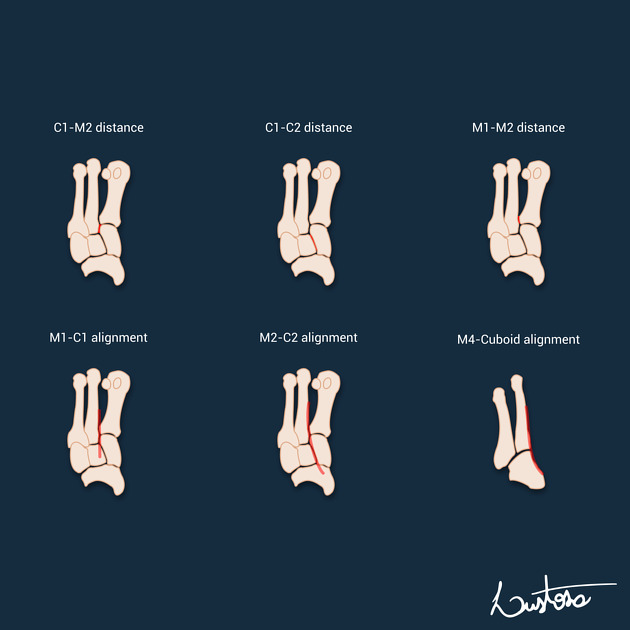Presentation
Trauma to the foot.
From the case:
Lisfranc injury - an approach














Download
Info

Illustration of common and useful measurement methods to the assessment of a Lisfranc injury.
-
C1-M2 distance: distance between the medial cuneiform (C1) and the 2nd metatarsal (M2)
-
C1-C2 distance: distance between the medial cuneiform (C1) and the intermediate cuneiform (C2)
-
M1-M2 distance: distance between the 1st metatarsal (M1) and the 2nd metatarsal (M2)
-
M1-C1 alignment: alignment between the lateral border of the base of the 1st metatarsal (M1) and the lateral border of the medial cuneiform (C1)
-
M2-C2 alignment: alignment between the medial border of the base of the 2nd metatarsal (M2) and the medial border of the intermediate cuneiform (C2)
- M4-Cuboid alignment: alignment between the medial border of the base of the 4th metatarsal (M4) and the cuboid (assessed on the oblique view)
Case Discussion
A Lisfranc injury (or tarsometatarsal injury) is a rare, yet extremely important, possible repercussion of trauma to the foot. Missing a Lisfranc injury may have dire consequences to the patient.
Some findings suggestive of a Lisfranc injury are:
- malalignment > 1 mm of M1-C1, M2-C2, and/or M4-Cuboid
- M1-M2 distance > 4 mm (non-weightbearing)
- M1-M2 distance > 5 mm (weightbearing)
- M1-M2 distance difference > 1 mm between feet (weightbearing)
- C1-M2 distance > 3 mm (non-weightbearing)
- C1-M2 distance > 5 mm (weightbearing)
- C1-M2 distance difference > 1 mm between feet (weightbearing)
- fleck sign - an avulsion fracture of the base of the 2nd metatarsal or medial cuneiform which is pathognomonic of a Lisfranc injury




 Unable to process the form. Check for errors and try again.
Unable to process the form. Check for errors and try again.